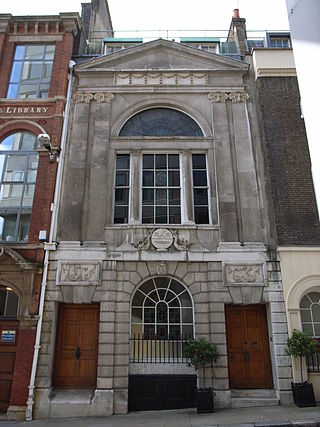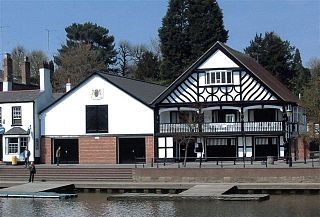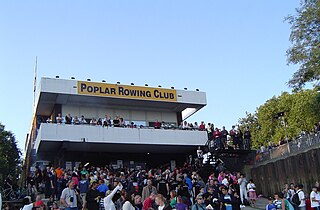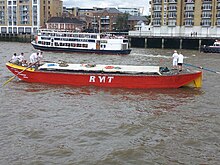
Narrow Street is a narrow road running parallel to the River Thames through the Limehouse area of east London, England. It used to be much narrower, and is the oldest part of Limehouse, with many buildings originating from the eighteenth century.

A lighterman is a worker who operates a lighter, a type of flat-bottomed barge, which may be powered or unpowered. In the latter case, it is usually moved by a powered tug. The term is particularly associated with the highly skilled men who operated the unpowered lighters moved by oar and water currents in the Port of London.

The Company of Watermen and Lightermen (CWL) is a historic City guild in the City of London. However, unlike the city's 111 livery companies, CWL does not have a grant of livery. Its meeting rooms are at Waterman's Hall on St Mary at Hill, London.

The Head of the River Race (HORR) is an against-the-clock ('processional') rowing race held annually on the River Thames in London, England, between eights, other such races being the Schools' Head of the River Race, Women's Head of the River Race and Veterans' Head of the River Race. Its competitors are, with a few experienced junior exceptions, seniors of UK or overseas competitors and it runs with the ebb tide down the 4.25 mile (6.8 km) Championship Course from Mortlake to Putney which hosts the Oxford and Cambridge head-to-head races usually between one and two weeks later.

The Championship Course is a stretch of the River Thames between Mortlake and Putney in London, England. It is a well-established course for rowing races, particularly the Oxford and Cambridge Boat Race. The course is on the tidal reaches of the river often referred to as the Tideway. Due to the iconic shape of the Championship Course, in orthopaedic surgery, an S-shaped incision along the crease of the elbow is commonly referred to as "a boat-race incision resembling the River Thames from Putney to Mortlake."

Vesta Rowing Club is a rowing club based on the Tideway of the River Thames in Putney, London, England. It was founded in 1870.

Doggett's Coat and Badge is the prize and name for the oldest continuous rowing race in the world. Up to six apprentice watermen of the River Thames in England compete for this prestigious honour, which has been held every year since 1715. The 4 mile 5 furlongs race is rowed on the River Thames upstream from London Bridge to Cadogan Pier, Chelsea, passing under a total of eleven bridges. Originally, it was raced every 1 August against the outgoing tide, in the boats used by watermen to ferry passengers across the Thames. Today it is raced at a time amenable to spectators, in September, that coincides with the incoming tide, in contemporary single sculling boats.

A waterman is a river worker who transfers passengers across and along city centre rivers and estuaries in the United Kingdom and its colonies. Most notable are those on the River Thames and River Medway in England, but other rivers such as the River Tyne and River Dee, Wales, also had their watermen who formed guilds in medieval times. Waterman can also be a person who navigates a boat carrying passengers. These boats were often rowing boat or boats with sails. Over the years watermen acquired additional skills such as local pilotage, mooring vessels at berths, jetties, buoys, and docks, and acting as helmsman aboard large vessel.

London Rowing Club is the second oldest of the non-academic active rowing clubs on the Thames in London, United Kingdom. It was founded in 1856 by members of the long-disbanded Argonauts Club wishing to compete at Henley Royal Regatta.

Sons of the Thames is a rowing club in Hammersmith, London, England. It was formed in Putney in 1886 with the aim, still enshrined in its constitution, to further the sport of rowing.
The Schools' Head of the River Race (SHORR) is the UK's largest school-age processional race and is organised by Westminster School for crews aged between 14 and 18 years old. It is held in Spring, the end of the head race season.

The Wingfield Sculls is a rowing race held annually on the River Thames in London, England, on the 4+1⁄4 miles (6.8 km) Championship Course from Putney to Mortlake.
The Thames is one of the main rowing rivers in Europe. Several annual competitions are held along its course, including the Henley Royal Regatta, The Boat Race and other long-distance events, called Head of the River races (Heads).

Tideway Scullers School is a rowing club on the Tideway of the River Thames next to Chiswick Bridge in Chiswick, London.

Grosvenor Rowing Club is based on the Groves in Chester. It rows on the River Dee and has around 30 km of rowable river, much of which straight and broad.

Auriol Kensington Rowing Club is a rowing club in Hammersmith, west London, England. The club was formed in 1981 by the amalgamation of Auriol Rowing Club which was founded in 1896 and Kensington Rowing Club which was founded in 1872. The clubhouse is on Lower Mall adjacent to Hammersmith Bridge.

Poplar Blackwall and District Rowing Club is a rowing club in Millwall, on the River Thames in England, on the northern bank of the Thames opposite Greenwich on the Isle of Dogs, London.
Kenneth Victor Dwan is a British former rower who competed in the Olympic Games in 1968 and 1972 and won the Wingfield Sculls six times.

James Arthur Messenger was a British sculler who was the world champion from 1854 to 1857. He served as the Queen's Bargemaster from 1862 to 1901. He resided in Teddington. In 1854 he became the Champion of the Thames which was effectively the English Sculling Championship and the World Sculling Championship. The English title gained the world status in 1876, earlier winners were retrospectively given the world champion title. In 1862 he won the famed Doggett's Coat and Badge, which claims to be the oldest sporting championship in the world. There is some confusion as to whether James Messenger who won the World Sculling Championship in 1854 is the same person, recorded as John Messenger of Cherry Garden Stairs, who won the Doggett's Coat and Badge in 1862.

Abingdon Rowing Club is a rowing club on the River Thames based on Wilsham Road in Abingdon-on-Thames, Oxfordshire.


















